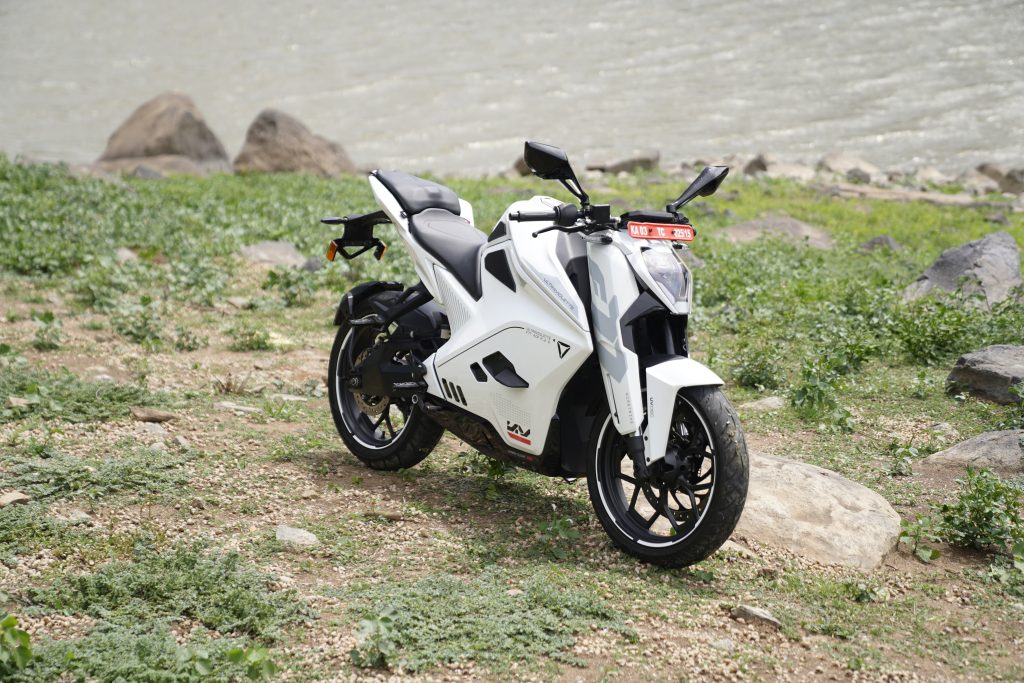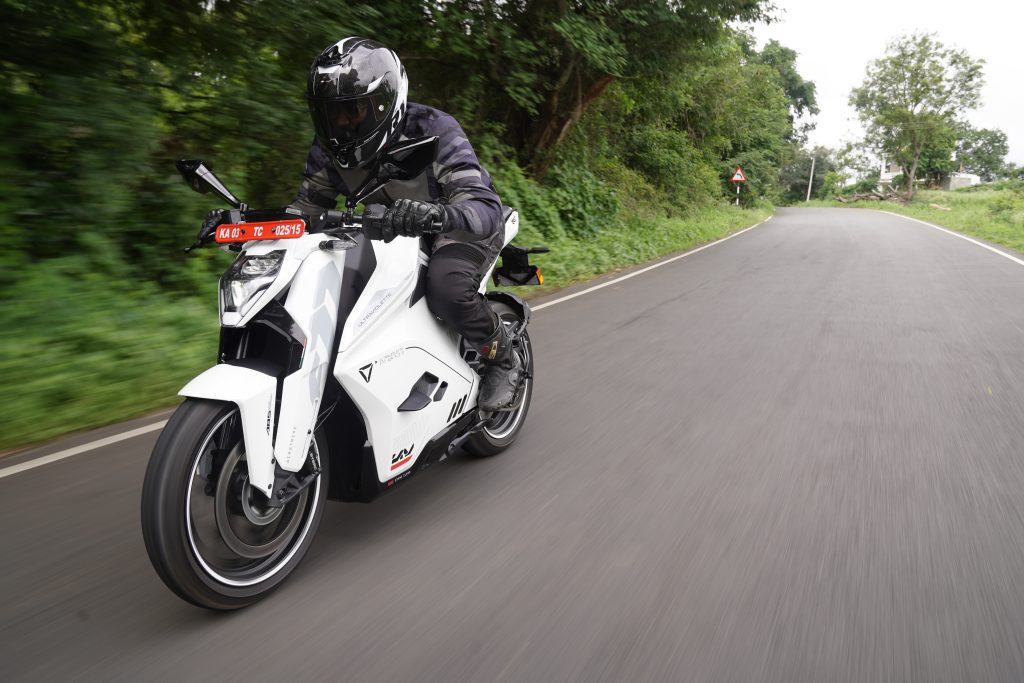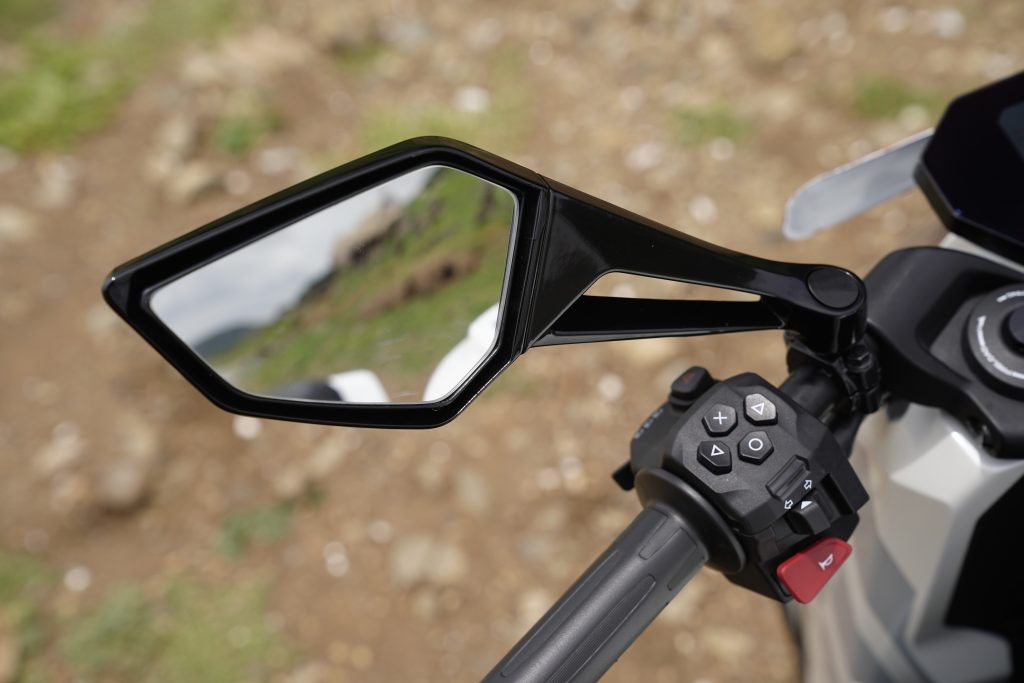Indigenous electric bike manufacturer Ultraviolette have updated their F77 Mach 2. They called us down south to experience it on some beautiful country roads.

Story: Charan Karthik
Photography: Sanjay Raikar
It has been more than a year since the F77 was launched, and Ultraviolette have now got us the Mach 2.
Cool is the name of the game. The Mach 2 oozes with character and seems like something that made its way from the future. There are no major changes to its appearance from the previous generation, yet the design looks absolutely fresh. At the event, Ultraviolette also claimed that the F77 is the only bike in the world to have no visible bolts, screws, or fasteners on its body panels. That is a remarkable achievement, one that is focused on aerodynamics and, for a smaller part, aesthetics.

We got the bike in the Stellar White colour and couldn’t be any happier. After a small demo by the Ultraviolette team on how to operate the new features, I got on to the bike and set off. The bike’s geometry is a good mix of sporty and relaxed; and I felt comfortable from the word go. An involuntary reflex saw me reaching for the clutch, early on. Well, jokes on me, as it only took a few minutes to get used to its absence, and from there on my left limbs were peacefully resting.

The F77 Mach 2 brings a few—necessary—updates to what is an already exciting package. The headliners are, a longer IDC range—323 kilometres and nine different levels of regenerative braking (regen) with an option to switch it completely off. I had the opportunity to ride the bike with all the different regen levels and was pleasantly surprised at how functional they were. They can be adjusted on the go, which is a feature that will come in handy. I mostly spent my time riding with the regen level set at seven or higher, as it suited my riding style the most. When set at level nine, the highest, I only required my right hand to open and close the throttle without even touching the brakes. The effect of the regen was astonishing and closely mimicked the engine braking that is available on combustion vehicles.
Braking hardware on the bike is made up of a 320-mm ByBre disc up front and a 230-mm disc at the rear. We did face an issue with the front brake wherein it slowly started to fade after using it extensively and riding the bike aggressively through the twisting roads. The brakes could have been calibrated better. I am sure out on the city roads, where the bike will spend most of its time, it will not be much trouble. The rear brake is best put as spongy.
The Mach 2 is by no means a light motorcycle, it continues to weigh 207 kg, one characteristic that makes it really cumbersome to live with in slow speeds. However, it has most of its mass centralized and squeezed in between your legs. Once I built up some speed, the bike felt much lighter than it is and darted with eagerness as I threw it into the corners. It does all of that without drama, and that is one thing I missed most while riding, as it provided a new experience, one that I was not used to. Since there is no noise from the motor, other sounds, like the occasional creak from under the instrument console and the squeak of the disc pads, made their way into my ears. The rear number plate holder also shuddered with every minor bump I passed over. Maybe this could have been better.

We rode the top-of-the-line Recon variant that comes equipped with a 10.3-kWh battery pack and a 30-kW motor. The bump in power is mild compared to its predecessor, with the bike now making 40.8-hp (up from 39.4) and a whopping 100 Nm of torque (a 5 Nm increase). On paper, the motor makes more torque than Triumph’s 765-cc Moto2-spec engine. Surely, this will be a bragging right for every owner who pulls up with the F77 Mach 2 to the weekend group ride. But I wouldn’t be doing justice to the British manufacturer if I compared the two bikes right?

Of the three riding modes on offer, we spent most of our time in “Ballistic”, where the entire power is on offer, taking the bike from zero to 60 km/h in a rush. It does take a while after that to get to 100 km/h, and then goes past 120 km/h a bit later. The top speed is also much higher now at a claimed 155 km/h (up from 147 km/h). The rest of the modes “Glide” and “Combat” limit power and acceleration. Glide is best used inside the city wherein the bike accelerates slowly and builds up momentum, and Combat is a mix of both the Ballistic and Glide, offering a sporty riding experience inside the city. But for a true blue enthusiast, the Ballistic mode is best-suited.
Now then, how does the Mach 2’s suspension behave? Well, the front and rear are so different. The setup at the front is comfortable, the damping is right and it provides a lot of feedback. The front felt sure-footed at most times. The rear however, was stiff, and the monoshock’s travel was less, which made for a rather bumpy ride.

Changes over its predecessor also include a longer riding range. Glide, Combat, and Ballistic now provide a claimed range of 266 km, 209 km, and 186 km respectively. There are also three new design categories, called the Laser, Shadow, and Airstrike; and three different colours in each design, bringing the total to nine. The Stellar White comes under Airstrike. The F77 Mach 2 Recon also gets an optional UV Care Max package which is an eight-year or eight-lakh-kilometre battery and drivetrain warranty. The Recon comes with a five-year or one-lakh-kilometre warranty as part of the standard package.

The bike also has the Delta Watch feature which alerts the owner by sounding an alarm and notifying their phone, if it senses any sort of tampering or motion when the key is not present. Also present is the Anti-collision Warning System, Crash Alert, Hill-hold and Remote Lockdown function.

The Ultraviolette F77 Mach 2 comes with a price tag of Rs 3.99 lakh for this Recon variant, with the Mach 2 base variant available for a more accessible introductory price of Rs 2.99 lakh. For a bike of such specification, it is quite a big ask. The Mach 2 is a great offer from the electric two-wheeler world but there still are niggles like fit-and-finish not being up to the mark, and the instrument cluster taking too long to boot up. If I were to buy it, I would buy it solely for what it is; a unique stand-out-from-the-crowd electric bike where people will most likely mistake me for the guy from the movie Tron.






Leave a Reply